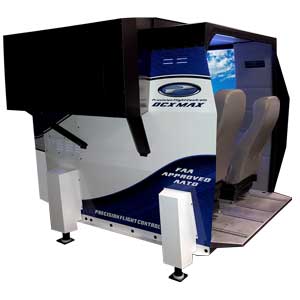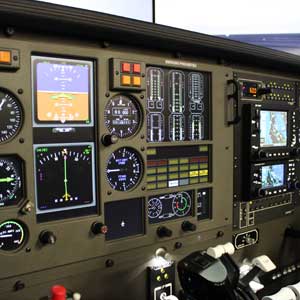
Raising the standards of pilot training by incorporating a highly sophisticated state-of-the-art simulator.

The Full Motion DCX-MAX Flight Simulator is a perfect tool for pilots and pilots in training to use to efficiently practice instrument approaches, along with improving pilot flight and communication skills. It includes 43 detailed aircraft simulations and has communication capability. The primary objective for the DCX-MAX Full Motion Sim is to provide a cost-efficient and effective educational tool in order to educate new students and to maintain flight currency for certified pilots.
Why Chose the DCX MAX Full Motion Flight Simulator?
The DCX MAX Full Motion Simulator was engineered to provide the pilot in training the best possible preparation. The DCX-MAX meet FITS (FAA/Industry Training Standards) requirements in order to improve pilot’s educational awareness and the satisfaction of personal accomplishment, while increasing safety of flight. It not only provides safety for the student, but also provides safety for the instructor.
DCX MAX NG
The DCX MAX NG is the newest cockpit AATD system on the market. The system boasts an impressive list of standard and optional features that make it the most advanced trainer in its class. The DCX MAX is deployed on six continents and is fast becoming one of the most popular cockpit AATD systems in the world.
Rates
1 hour: $45.
Standard Features | Optional Features |
|---|---|
|
|
FAA approved AATD

Approved for use under Part 61 as follows:
§ 61.51(b)(3)
Simulated instrument conditions
§ 61.51(h)
Logging Training Time
§ 61.57(c)
Instrument Experience (Maintaining Currency – Simulator Only)
- Within the two (2) Calendar Months Preceding the Month of the Flight
- Three Hours of Instrument Experience
- Six Instrument Approaches
- Holding Procedures and Tasks
- Two unusual attitude recoveries while in a descending Vne airspeed condition and two unusual attitude recoveries while in an ascending, stall speed condition
- Intercepting and Tracking Courses Through the Use of Navigational Electronic Systems
- Self-Loggable (No Instructor Endorsement Required)
§ 61.57(d)(1)(ii)
Instrument Proficiency Check (per FAA-S-8081 – latest version)
- Holding Procedures
- Unusual Attitudes
- Intersecting and Tracking Navigational Systems and DME Arcs
- Non-Precision Approach
- Precision Approach
- Missed Approach
- Approach with Loss of Primary Flight Instrument Indicators
The following IPC tasks must be accomplished in an Aircraft
- Circling Approach (SE/ME IPC)
- Landing from a Straight-in or Circling Approach (SE/ME IPC)
- One Engine Inoperative During Straight-and-Level Flight (ME IPC)
- One Engine Inoperative Instrument Approach (ME IPC)
§ 61.65(i)
Instrument Rating: Up to 20 Hours
§ 61.109(k)(1)
Private Pilot Certificate: Up to 2.5 Hours
§ 61.129(i)(1)(i)
Commercial Certificate: Up to 50 Hours
§ 61.159(a)(4)(i)
Airline Transport Pilot Certificate: Up to 25 Hours
§ 141.41(b)
Approved for use under the Part 141 Appendices as follows:
- Appendix B Up to 15% toward the total Private Pilot flight training time requirements
- Appendix C Up to 40% towards the total Instrument Rating flight training time requirements
- Appendix D Up to 20% towards the total Commercial Pilot flight training time requirements
- Appendix E Up to 25% towards the total Airline Transport Pilot flight training time requirements
- Appendix F Up to 5% towards the total Flight Instructor flight training time requirements
- Appendix G Up to 5% towards the total Flight Instructor Instrument flight training time requirements
- Appendix I Private Pilot Airplane Single Engine or Multi-Engine Class Rating Course up to 3 hours towards the flight training time requirements
- Appendix I Commercial Pilot Airplane Single Engine or Multi-Engine Class Rating Course up to 11 hours towards the flight training time requirements
- Appendix I Airline Transport Pilot Airplane Single Engine or Multi-Engine Class Rating Course up to 6.25 hours towards the flight training time
- Appendix M Up to 25% towards the total Combined Private Pilot Certification and Instrument Rating flight training time requirements.
